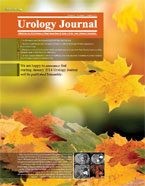Ureteroscopy:The First-Line Treatment for Distally Located Ureteral Stones Smaller Than 10 mm
Urology Journal,
Vol. 10 No. 4 (2013),
4 January 2014
,
Page 1028-1034
https://doi.org/10.22037/uj.v10i4.1556
Abstract
Purpose: To compare the efficacy of different treatment strategies for distal ureteral stones smaller than 10 mm.
Material and Methods: A total 127 patient were included in the study. Based on the treatment modality , patients were divided into three groups. Patients in group 1 only received conventional treatment including daily hydration of 2500 mL, ciprofloxacin, diclofenac sodium and a spasmolytic agent; group 2 patients received conventional treatment (daily hydration of 2500 mL, ciprofloxacin, diclofenac sodium and a spasmolytic agent) and tamsulosin 0.4 mg orally daily for 4 weeks; and group 3 patients underwent ureteroscopy. Patients were further subdivided into 2 categories based on maximum stone diameter: category A (less than 5 mm) and category B (5.0-9.9 mm). Following treatment, all groups were compared in terms of stone-free rate and time to expulsion.
Results: Following treatment, the stone-free rates for groups 1, 2 and 3 were 48.7%, 59.5% and 95.6%, respectively (P < .0001). The mean expulsion times for groups 1, 2 and 3 were 15.3 ± 5.33, 15.1 ± 5.5 and 1.95 ± 2.2 days, respectively (P < .001). Compared to the other treatments, the stone-free rate and mean expulsion time in the ureteroscopy group were significantly increased and decreased, respectively.
Conclusion:
There are several treatment options for distal ureteral stones. Based on our data,we conclude that ureterorenoscopy should be the standard of care for distal ureteral stones smaller than 10 mm.
How to Cite
- Abstract Viewed: 265 times
- PDF Downloaded: 237 times
